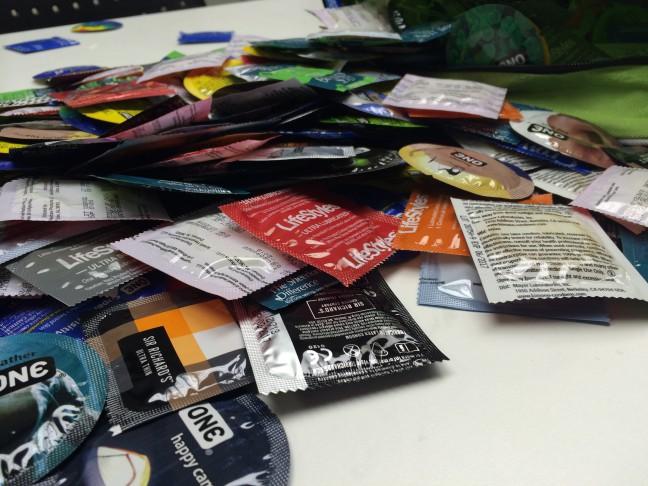’Tis the season for roses, heart-shaped boxes full of chocolate, sappy gifts and … bondage. Due to the upcoming release of the film “Fifty Shades of Grey,” BDSM has found an unusually bright spotlight. BDSM is an acronym for Bondage/Discipline, Dominance/Submission and Sadism/Masochism. Every activity under BDSM is consensual; without this crucial part, such behaviors become abusive.
Bondage involves tying, binding or restraining a partner. Discipline includes any element of punishment involved in a BDSM “scene” (a previously agreed-upon amount of time dedicated to “play”). Dominance and submission describe the power relationship among partners. All participants derive pleasure from dominating or being dominated. Control or loss of control is a key ingredient for many people who enjoy BDSM. Dominant and submissive roles may also be called “tops” and “bottoms.” A “switch” enjoys both roles. Inflicting pain turns on sadists, while masochists find experiencing pain pleasurable. These roles may overlap or combine to form a particular experience of BDSM.
Hump Day on the elusive, infrequent nature of female orgasms
“Fifty Shades of Abuse”?
Most of us know “Fifty Shades of Grey” began as “Twilight” fan fiction, but this is hardly the worst of it. Both the book and film depict BDSM as an abusive relationship without equal agency of both partners. Using the Center for Disease Control’s standards of emotional abuse and sexual violence, social scientists found that nearly every interaction between Anastasia and Christian was abusive. When Anastasia gets drunk, Christian takes advantage of her, undressing her in his hotel room without consent — even though she asked him to take her home. Anastasia consistently blames herself for anything that goes wrong between them and relies on Christian to validate her attractiveness and self-worth.
The book contains rampant slut-shaming, most starkly depicted in E.L. James’ sexualization of Anastasia’s virginity. And the kink introduced by Christian is definitely varsity-level stuff; just like anything in the bedroom, it needs to be worked up to, and Anastasia’s lack of experience makes her an easy target. Christian stalks and manipulates her, initiates lots of sexual activity without her consent (we call that rape), ignores her safe word and advances the myth that kinky people are survivors of abuse.
In order for BDSM to be pleasurable and safe for everyone, it is essential to discuss and consent to each and every activity — an element neglected almost entirely by Christian (except when he introduces a contract, which Anastasia never signs). Although “Fifty Shades of Grey” can be used to inspire and arouse, it should not be used as a manual for BDSM. While there is nothing inherently harmful about BDSM, romanticizing and sexualizing aggression is dangerous.
Why does it hurt so good?
Playing with power roles and pain might seem like an irrational choice, especially if it’s with someone we love. Being tied up or involved in dom/sub play can induce an altered state of consciousness. Many submissive partners report feelings of freedom, presence and reduced anxiety. Dominants, on the other hand, describe feelings of deep concentration and focus. Enjoying pain can lead to an adrenaline rush, creating a feeling similar to a “runner’s high.” People who play both roles claim to feel closer to their partners after partaking in BDSM.
Plus, our bodies are built for experiencing pleasure and pain together. The same chemicals and areas of the brain that control pleasure control pain, too. This explains why being spanked, flogged or paddled can be erotic and enjoyable for some people. People who are experiencing pleasure also have a higher tolerance for pain— especially women. So if a person is really turned on and their partner spanks them, it might sting less. Some people are turned on by the sound of spanking or flogging in addition to the feeling. Red marks, hickeys, bruises and ropes also hold some aesthetic appeal for many kinky folks. The power roles involved in domination and submission can be just a thrilling game of cops and robbers — with your pants off.
Consent
Consent is the most important part of BDSM. Without it, a perfectly healthy dom/sub relationship is abuse. BDSM is not for everyone. Those who practice BDSM often refer to the acronym R.A.C.K.: Risk-Aware Consensual Kink. Thus, all parties should be aware of the precise risks involved and consent to them accordingly. Here are the tools you need to practice BDSM sanely and consensually:
- Negotiate the scene beforehand. Do not attempt to discuss BDSM in the bedroom, where there might be pressure to perform immediately. Discuss what you both want to happen, your limits and set rules. Consider drawing up a written agreement, particularly for very risky activities. Talk about what you’ll each need after the scene is done.
- Use a safeword. These should be discussed during negotiations so that the scene can be stopped at any moment. A safeword should not be words like “no,” “stop” and “don’t,” because some scenes may involve a submissive who uses these words (often to create an illusion of lack of consent; of course, this illusion is consensual in itself). Common safe words include “red” (stop), “yellow (slow down) and “green” (go ahead). If a partner is gagged or unable to speak, they should be given a bell to ring or a ball to drop.
- Know your body. It is important not only to realize what you like and dislike, but what parts of the body can be damaged by BDSM. Never tie around joints, as the ropes can cut off circulation. The best place to use floggers, whips and paddles is on meaty areas of the body (thighs, butts, etc.). If you’re using tools like these, consider testing them on yourself to gauge how they feel.
- Consider your triggers. Some aspects of BDSM can trigger negative reactions. Partners may experience flashbacks to abuse or be overwhelmed by what they are thinking and feeling. While negotiating, consider everything that could make you or your partner uncomfortable, and use your safe word any time you feel as though you have reached your limit.
Aftercare
Aftercare is the important (and often overlooked) process of taking care of one another after engaging in a potentially exhausting BDSM scene. Some people may want to rest, be left alone or process the experience in their own way. Common aftercare rituals include hugging, kissing, cuddling, complimenting, affirming an emotional bond, stroking hair or any other number of activities (sexual or otherwise). Aftercare is not just for the submissive partner; doms like to be snuggled afterward, too! Make sure to be receptive to what your partner needs and express your own needs.
Sexual preference is a wonderland meant for people to explore and safely experiment with. Nothing about enjoying BDSM indicates a psychological problem or history of abuse, so never feel shamed or dirty for enjoying something that others do not. So maybe this Valentine’s Day, take your sweetheart to Home Depot and pick out a nice rope for a consensual night of BDSM.














